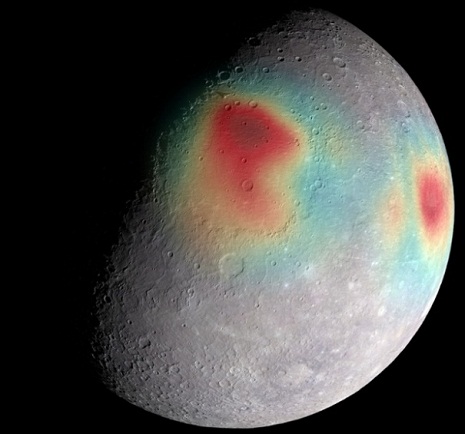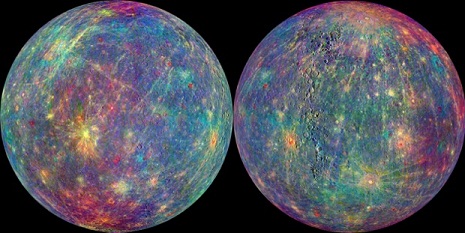Out of fuel after more than a decade in space, the robotic Messenger probe slammed into the planet at about 3.26pm ET, on the far side of Mercury and out of sight of telescopes.
Hurtling toward the planet at more than 8,700mph (3.9km per second), Messenger smashed into a plain smoothed over by past lava floods, according to Nasa’s estimates. The probe crashed near a large impact basin named Shakespeare, a 250-mile-diameter zone of craters; Messenger’s own crater is estimated to be 52ft at its widest.
Nasa confirmed the impact at 3.26 pm ET after the spacecraft failed to reappear for its 4,105th orbit and make contact with its handlers on Earth.
“Going out with a bang as it impacts the surface of Mercury, we are celebrating Messenger as more than a successful mission,” said John Grunsfeld, associate administrator for Nasa Science Mission Directorate in Washington.
Messenger is the first spacecraft to have orbited the planet closest to the sun, and has sent back to Earth hundreds of thousands of images of the blistered world, where temperatures can surpass 800F (427C) in the day and -290F (-180C) at night.
Nancy Chabot, an instrument scientist for Messenger with Johns Hopkins Applied Physics Lab, said “the mission has revolutionized what we know about Mercury, we are rewriting the book on it. We literally have plans for a new Mercury book”.
“It’s definitely said but we are trying to celebrate how much it’s accomplished,” Chabot said. “It’s a challenging thing to put a spacecraft in orbit around Mercury, where, well, it gets hot. It’s been a constant learning curve and the spacecraft has had to do some interesting maneuvers – it’s not just the sun that’s hot, the planet’s surface is also radiating heat.”
Nasa launched Messenger toward Mercury in 2004, and the vessel borrowed gravity and sailed the pressure of sunlight (“solar sailing”) for seven years, looping its way around planets until finally it reached orbit around the planet closest to the sun.
“The mission was designed to last one year, and here we are four years later, with 277,000 images. In the original proposal it said something like 2,500 images. We’ve really surpassed all expectations.”
There was no doubt however that Messenger’s time had come to finally reach the surface of the planet it had circled for years: “It’s just a matter of when at this point,” Chabot said.
During its four years in orbit, Messenger delivered massive amounts of data to scientists, who have hailed the mission as a spectacular success. Among its discoveries was Mercury’s polar regions contain large quantities of frozen water, under a mysterious “dark layer” of material that may be organic compounds.
Chabot and others will now set to work mining the massive trove of data about the planet. They will map the polar deposits in detail and try to pin down when ice reached the planet, which in turn could help understand how water is distributed around the solar system.
Sean Solomon, the principal investigator for the mission and recent recipient of the national medal of science, said earlier in April that “this dark material [may] in fact be organic, carbonaceous material delivered to Mercury … the building blocks for organic chemistry and life.”
Messenger also found that the planet’s volcanic, scarred surface comprises a far greater variety of elements and minerals than scientists had expected, and that the planet has a puzzling magnetic field that is offset 20% from the north pole, unlike the more centred, symmetrical field of Earth, where the offset is more like 11%.
The discoveries of Mercury’s strange makeup “throws some of their models out” about how the planet and solar system formed, Chabot said, forcing scientists to overhaul their hypotheses.

The mission has also provided striking mapped images of the planet, showing signs of volcanoes erupting from underneath ancient lava fields and strange “hollows”, which are steep holes in the surface where materials seemingly vaporized or boiled away into airless space.
“The hollows are still this mysterious feature,” Chabot said, “where it looks like we’re actively losing material off of the planet, but we don’t have detailed explanation why.”
Other discoveries include the curious facts that Mercury has shrunk by several kilometers since the planet formed, that swirling space weather events occur at Mercury, and that Mercury may be “a giant dust collector”, as Nasa planetary dynamist Joseph Hahn said last year, where periodic meteor showers strike and scatter material.
Chabot said the Messenger teams plan to put as much as possible of the data into public archives, so that people can study the knowledge without necessarily needing Nasa’s sophisticated technology – and to inspire new questions and answers.
“There will be things we haven’t even thought of,” Chabot said. “If you make all the data available, new science questions come.”
Although Nasa scientists hope for an eventual lander mission to Mercury, the next mission to the planet will be run by the European Space Agency, whose BepiColombo mission should reach orbit in the 2020s.
More about:
















































